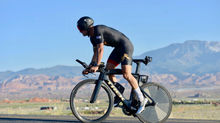Preventing Heat Illness
- Jason Lentzke
- Jun 3, 2023
- 3 min read

“Sad, frustrated, a million different things,” Sarah True told Triathlonworld.com. “You never expect to be in the position where you have a seven-minute gap, and your brain doesn’t function well enough to tell you you’re struggling in the heat. Just stop and walk a little because I still would have won. When your brain goes in the heat, there’s not a lot you can do.”
Some of you may have seen the video of Sarah True that went around last week after IRONMAN Frankfurt. If you haven’t, you can see it here. While I will not take away from Sarah’s performance, it was gutsy indeed, I want to make sure to address a couple of issues:
Contrary to the race announcers, this was not a case of hypoglycemia. While that is a nutrition issue in itself, in the video above, Sarah is exhibiting clear signs of exertional heat illness. This happens when the amount of heat an athlete is producing, combined with an environment that doesn’t allow for cooling (a combination of high heat and humidity) causes the athlete’s core body temperature to rise. In Sarah’s case, to be exhibiting these symptoms (confusion, staggering, lack of coordination) it is likely that her core body temperature is well above 40*C or 104* F. For reference, the temperature that most of us will stop ourselves is around 39*C or slightly over 102*F. This point of 39-40*C is usually where our brain says “enough is enough” and we start to back off our efforts. Because of Sarah’s incredible training and athleticism she was able to push pass this point. This is a blessing and a curse. As you can see from her performance at IRONMAN Frankfurt she reached a point that is far too dangerous. When we reach this level of exertional heat illness we run the risk of serious injury and even death.
So, what can we do to prevent heat illness and what are some signs that shouldn’t be ignored? As both North America and Europe races enter their hottest months, I’ve included some strategies to take care of yourself while racing in the heat.

1. Proper hydration is KEY. I cannot stress this enough. This does not only include proper hydration in racing or training but OUTSIDE of those time as well. As athletes, we should be aiming to drink 2-2.5 L/day PLUS what we lose during training. Know how much sweat you are losing in training. Jason has a great article on calculating your sweat rate here. Once you know your sweat rate, aim to replenish that loss while you train. If you fall short of that, it is imperative to make up that difference throughout your day.
2. Acclimate. It is necessary to train in the heat and humidity to adapt to the heat and humidity. This does not mean putting yourself at unnecessary risk, but you do want to simulate racing conditions as best as possible. It takes 7-10 days to be acclimated to new conditions. Over this time, exercise intensity/volume should be gradually increased. (A three-hour trainer ride indoors with fans will not prepare you for racing in the heat and humidity).
3. Pay attention to signs of overheating. This includes; lightheadedness, headaches, chills (especially when it’s hot out) stomach cramps, and nausea. If you experience these symptoms, stop training. The most practical way to cool yourself is a cold shower.
4. If you have ever experienced a heat illness be extremely cautious when training or racing in the heat. One of the key predictors of heat illness is by having previously experienced it.
If you have any questions at all regarding heat and hydration please don’t hesitate to reach out. First and foremost, all the coaches at Toro Performance want you to stay safe and healthy while training and racing.























